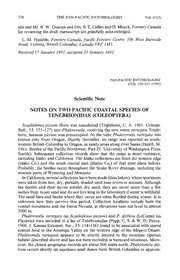
Notes on two Pacific coastal species of Tenebrionidae (Coleoptera) PDF
Preview Notes on two Pacific coastal species of Tenebrionidae (Coleoptera)
226 THE PAN-PACIFIC ENTOMOLOGIST Vol. 67(3) site and Mr. R. W. Duncan and Drs. B. E. Callan and H. Moeck, Forestry Canada for reviewing the draft manuscript are gratefully acknowledged. L. M. Humble, Forestry Canada, Pacific Forestry Centre, 506 West Burnside Road, Victoria, British Columbia, Canada V8Z 1M5. Received 17 January 1991; accepted 31 January 1991. PAN-PACIFIC ENTOMOLOGIST 67(3): 226-227, (1991) Scientific Note NOTES ON TWO PACIFIC COASTAL SPECIES OF TENEBRIONIDAE (COLEOPTERA) Scaphidema pictum Horn was transferred (Triplehom, C. A. 1961. Coleopt. Bull., 15: 125-127) into Phaleromela, receiving the new name variegata Triple¬ hom, because pictum was preoccupied. At the time Phaleromela variegata was known only from Oregon. Shortly thereafter, its range was reported as south¬ western British Columbia to Oregon, in sandy areas along river banks (Hatch, M. 1965. Beetles of the Pacific Northwest. Part IV. University of Washington Press, Seattle). Subsequent collection records show that the range is more extensive, including Idaho and California. The Idaho collections are from the western edge (Idaho Co.) and the south central part (Blaine Co.) of that state (data below). Probably, the beetles occur throughout the Snake River drainage, including the western parts of Wyoming and Montana. In California, several collections have been made (data below), where specimens were taken from fine, dry, partially shaded sand near rivers or streams. Although the beetles and their larvae inhabit dry sand, they are never more than a few inches from moist sand and do not live long in the laboratory if water is withheld. The sand bars and banks where they occur are often flooded during winter. It is unknown how they survive this period. Collection localities include both the coastal mountains and the Sierra Nevada, at elevations near sea level to almost 2000 m. Phaleromela variegata (as Scaphidema pictum) and P. globosa (LeConte) (as Phaleria) were included in a list of Tenebrionidae (Papp, C. S. & W. D. Pierce. 1960. J. Kansas Entomol. Soc., 33: 154-156) found to be associated with stored animal food in the Antelope Valley on the western edge of the Mojave Desert. Phaleromela variegata appears to be strictly limited to the montane riparian habitat described above and has not been recorded in barnyard situations. More¬ over, the closest geographic records are about 500 miles north. Phaleromela glo¬ bosa occurs strictly on maritime sand dunes from British Columbia to approxi- 1991 SCIENTIFIC NOTE 227 mately San Luis Obispo in central California, with no other records from interior localities. Thus, both the occurrence of these species in the Mojave Desert and their association with stored products need verification. Diaperis californica Blaisdell, described in 1929, has remained rare in collec¬ tions. In a revisionary treatment (Triplehom, C. A. 1965. Proc. U.S. Nat. Mus., 117: 349-458) only 14 specimens were recorded from four localities in Calaveras, Placer, Madera and Fresno Counties. We provide additional locality records (see below), with localities from the San Bernardino Mountains being outside the Sierra Nevada and about 300 miles south of the previously known range. Records. — Phaleromela pictum: CALIFORNIA. MENDOCINO Co.: Eel River Ranger Station, nr Covelo, 9 Jun 1972; 4.8 km (3 mi) N of Branscomb, 18 May 1984. PLUMAS Co.: Humbug Creek, 4.8 km (3 mi) NW of Portola, 1584 m (5200 ft), 18 May 1982; 1.6 km (1 mi) S of Meadow Valley, 1173 m (3850 ft), 14 May 1982. SISKIYOU Co.: 14.4 km (9 mi) E of McCloud, 1067 m (3500 ft), 10 Jun 1974. TRINITY Co.: Hayfork Ranger Station, nr Hayfork, 23 May 1973; Forest Glen, 5 Jun 1988. IDAHO. BLAINE Co.: Big Woods River, 32 km (20 mi) N of Shoshone, 1 Jul 1966. IDAHO Co.: Stites, 31 May 1975. Diaperis californica: CALIFORNIA. CALAVERAS Co.: 6.4 km (4 mi) E of Murphy’s, 914 m (3000 ft), 12 Jul 1963. EL DORADO Co.: Blodgett Experimental Forest, 20.8 km (13 mi) E of Georgetown, 21 Jun 1981, blacklight. MARIPOSA Co.: El Portal, 16 Jun 1961, ex Laetoporis sulphureus (Bulliard ex Fries). Yosemite National Park, Tenaya Canyon, 960 m (3150 ft), 17 May 1928. SAN BERNAR¬ DINO Co.: Crestline, 1494 m (4900 ft), 5 Jul 1968; Lake Arrowhead, 2 Jul 1949. TUOLUMNE Co.: Twain Harte, 21 Jun 1961. Acknowledgment.—The single fungal association listed was provided by J. F. Lawrence (CSIRO, Canberra, Australia). John T. Doyen1 and F. T. Hovore,2 1 Department of Entomological Sciences, University of California, Berkeley, California 94720; 2Placerita Canyon Nature Center, Newhall, California 91321. Received 20 January 1991; accepted 11 March 1991.
